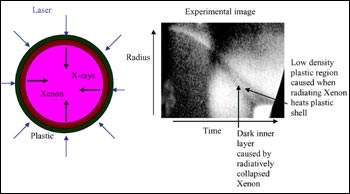This area deals with the fundamental laws and building blocks of nature and how they interact, the properties and the behavior of matter, and research into space and time and their structures.
innovations-report provides in-depth reports and articles on subjects such as astrophysics, laser technologies, nuclear, quantum, particle and solid-state physics, nanotechnologies, planetary research and findings (Mars, Venus) and developments related to the Hubble Telescope.

An international team of astronomers from France, Italy, the UK and Australia has found a previously unknown galaxy colliding with our own Milky Way. This newly-discovered galaxy takes the record for the nearest galaxy to the centre of the Milky Way.
Called the Canis Major dwarf galaxy after the constellation in which it lies, it is about 25000 light years away from the solar system and 42000 light years from the centre of the Milky Way. This is closer than the Sagittarius dwarf galaxy, dis

Since Tuesday 28 October, explosive events originating from the Sun have been bathing the Earth and its surroundings in high energy radiation.
Although 150 million kilometers away, the Sun is still capable of causing major disruption here on Earth to a range of systems that we depend on in everyday life. These include communication and navigation systems, aircraft and spacecraft operations and the distribution of electricity at high latitudes.
The activity started on Tuesday

Razor-sharp optics on ground-based telescopes now allows astronomers to peer at events occurring near the very edge of our galaxy’s central black hole, providing new clues about the massive but invisible object at the core of the Milky Way.
In a paper in this week’s issue of Nature, a team led by University of California, Berkeley, physicist Reinhard Genzel, who also directs the Max-Planck Institute for Extraterrestrial Physics (MPE) in Garching, Germany, reports the detection of p

VLT Observes Infrared Flares from Black Hole at Galactic Centre
An international team of astronomers led by researchers at the Max-Planck Institute for Extraterrestrial Physics (MPE) in Garching (Germany) has discovered powerful infrared flares from the supermassive black hole at the heart of the Milky Way.
The signals, rapidly flickering on a scale of minutes, must come from hot gas falling into the black hole, just before it disappears below the “event horizon” of the monst

A mysterious arc of light found behind a distant cluster of galaxies has turned out to be the biggest, brightest and hottest star-forming region ever seen in space.
The so-called Lynx Arc is one million times brighter than the well-known Orion Nebula, a nearby prototypical ’starbirth’ region visible with small telescopes. The newly identified super-cluster contains a million blue-white stars that are twice as hot as similar stars in our Milky Way galaxy. It is a rarely glimpsed exa

45th Annual Meeting of the Division of Plasma Physics
The emerging field of high energy density physics has been described by a recent National Academy of Science report as the “X-games” of contemporary science. The term high energy density is used to describe matter with pressures more than 1 million times the pressure on the surface of the earth. While high energy density matter is extreme by terrestrial standards, it can be found throughout the universe in a number of astrophysica